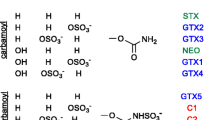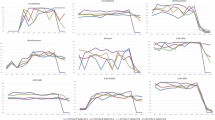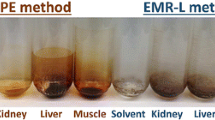Abstract
The ability to detect chemical contaminants, including veterinary drug residues in animal products such as fish, is an important example of food safety analysis. In this paper, a liquid chromatography high-resolution mass spectrometry (LC-HRMS) screening method using a quadrupole-Orbitrap instrument was applied to the analysis of veterinary drug residues in incurred tissues from aquacultured channel catfish, rainbow trout, and Atlantic salmon and imported aquacultured products including European eel, yellow croaker, and tilapia. Compared to traditional MS methods, the use of HRMS with nontargeted data acquisition and exact mass measurement capability greatly increased the scope of compounds that could be monitored simultaneously. The fish samples were prepared for analysis using a simple efficient procedure that consisted of an acidic acetonitrile extraction followed by solid phase extraction cleanup. Two different HRMS acquisition programs were used to analyze the fish extracts. This method detected and identified veterinary drugs including quinolones, fluoroquinolones, avermectins, dyes, and aminopenicillins at residue levels in fish that had been dosed with those compounds. A metabolite of amoxicillin, amoxicillin diketone, was also found at high levels in catfish, trout, and salmon. The method was also used to characterize drug residues in imported fish. In addition to confirming findings of fluoroquinolone and sulfonamide residues that were found by traditional targeted MS methods, several new compounds including 2-amino mebendazole in eel and ofloxacin in croaker were detected and identified.

Aquacultured samples are analyzed with a high-resolution mass spectrometry screening method to detect and identify unusual veterinary drug residues including ofloxacin in an imported fish.






Similar content being viewed by others
References
World Bank Report. Fish to 2030: Prospects for Fisheries and Aquaculture. 2013.
Boison JO, Turnipseed SB. A review of aquaculture practices and their impacts on chemical food safety from a regulatory perspective. J AOAC Int. 2015;98:541–9.
Love DC, Rodman S, Neff RA, Nachman KE. Veterinary drug residues in seafood inspected by the European Union, United States, Canada, and Japan from 2000 to 2009. Environ Sci Technol. 2011;45:7232–40.
Morris DJ, Gray AJ, Kay JF, Gettinby G. EU sampling strategies for the detection veterinary drug residues in aquaculture species: are they working? Drug Testing Anal. 2012;4:1–9.
US Government Accounting Office (GAO). Imported Seafood Safety: FDA and USDA could strengthen efforts to prevent unsafe drug residues. Report to the Chairman, Committee on Appropriations, US Senate. 2017;GAO-17-443.
Storey JM, Clark SB, Johnson AS, Andersen WC, Turnipseed SB, Lohne JJ, et al. Analysis of sulfonamides, trimethoprim, fluoroquinolones, quinolones, triphenylmethane dyes and methyltestosterone in fish and shrimp using liquid chromatography mass spectrometry. J Chromatogr B. 2014;972:38–47.
Cháfer-Pericás C, Maquieira Á, Puchades R, Company B, Miralles J, Moreno A. Multiresidue determination of antibiotics in aquaculture fish samples by HPLC–MS/MS. Aquaculture Res. 2010;41(9):e217–e25.
Guidi LR, Santols FA, Ribeiro ACSR, Fernandes C, Silva LHM, Gloria MBA. A simple, fast and sensitive screening LC-ESI-MS/MS method for antibiotics in fish. Talanta. 2017;163:85–93.
Turnipseed SB, Lohne JJ, Boison JO. Review: application of high resolution mass spectrometry to monitor veterinary drug residues in aquacultured products. J AOAC Int. 2015;98:550–8.
Jia W, Chu X, Chang J, Wang PG, Chen Y, Zhang F. High-throughput untargeted screening of veterinary drug residues and metabolites in tilapia using high resolution orbitrap mass spectrometry. Anal Chim Acta. 2017;957:29–39.
Justino CIL, Duarte KR, Freitas A, C., Panteleitchouk TSL, Duarte AC, Rocha-Santols TAP. Contaminants in aquaculture: overview of analytical techniques for their determination. Trends Anal Chem 2016;80:293–310.
Santols L, Ramos F. Analytical strategies for the detection and quantification of antibiotic residues in aquaculture fishes: a review. Trends Food Sci Tech. 2016;52:16–30.
Turnipseed SB, Storey JM, Lohne JJ, Andersen WC, Burger RJ, Johnson AS, et al. Wide-scope screening method for multi-class veterinary drug residues in fish, shrimp, and eel using liquid chromatography-quadrupole high-resolution mass spectrometry. J Agric Food Chem. 2017;65:7252–67.
Meinertz J, Schreier T. Depletion of isoeugenol residues from the fillet tissue of AQUI-S exposed rainbow trout (Oncorhynchus mykiss). Aquaculture. 2009;296:200–6.
Inglis V, Soliman MK, Higuera Ciapara I, Richards RH. Amoxycillin in the control of furunculosis in Atlantic salmon parr. Vet Rec. 1992;130:45–8.
FDA. Chemotherapeutics in Seafood Compliance Program 7304.018 2017.
FDA. Acceptance criteria for confirmation of identity of chemical residues using exact mass data for the FDA Foods and Veterinary Medicine Program. 2015.
Casey CR, Nickel T, Bradley JD, Ayres P. A rapid liquid chromatography-fluorescence detection for the quantitative analysis of avermectin residues in salmon and trout. FDA Laboratory Information Bulletin. 2018; in progress.
Casey CR, Karbiwnyk CM, Andersen WC, Ayres P. Liquid chromatography-tandem mass spectrometry method for the confirmation and quantitative analysis of avermectin residues in salmon. FDA Laboratory Information Bulletin. 2011;4496.
Andersen WC, Casey CR, Schneider MJ, Turnipseed SB. Expansion of scope of AOAC first action method 2012.25; single laboratory validation of triphenylmethane dye and leuco metabolite analysis in shrimp, tilapia, catfish and salmon by LC-MS/MS. J AOAC Int. 2015;98:636–48.
Endtz HP, Ruijs GJ, van Klingeren B, Jansen WH, van der Reyden T, Mouton RP. Quinolone resistance in campylobacter isolated from man and poultry following the introduction of fluoroquinolones in veterinary medicine. J Antimicrob Chem. 1991;27:199–208.
Roybal JE, Walker CC, Pfenning AP, Turnipseed SB, Storey JM, Gonzales SA, et al. Concurrent determination of four flouroquinolones in catfish, shrimp, and salmon by liquid chromatography with fluorescence detection. J AOAC Int. 2002;85:1293–301.
Parshikov IA, Heinze TM, Moody JD, Freeman JP, Williams AJ, Sutherland JB. The fungus Pestalotiopsis guepini as a model for biotransformation of ciprofloxacin and norfloxacin. Appl Microbiol Biotechnol. 2001;56(3–4):474–7.
Stein GE. Review of the bioavailability and pharmacokinetics of oral norfloxacin. Am J Med. 1987;82:18–21.
Wang Q, Liu Q, Li J, Wang Q. Tissue distribution and elimination of norfloxacin in Japanese sea perch (Lateolabras japonicus) and black sea bream (Sparus macrocephalus) following multi-oral administration. Aquaculture. 2008;278:1–4.
Horsberg TE. Avermectin use in aquaculture. Curr Pharm Biotechnol. 2012;13:1095–102.
Whyte SK, Westcott JD, Byrne P, Hammell KL. Comparison of the depletion of emamectin benzoate (SLICE®) residues from skeletal muscle and skin of Atlantic salmon (Salmo salar), for multiple dietary dose regimens at 10 °C. Aquaculture. 2011;315:228–35.
Verdon E, Andersen WC. Certain dyes as pharmacologically active substances in fish farming and other aquaculture products. In: Kay JF, MacNeil J, Wang J, editors. Chemical analysis of non-antimicrobial veterinary drug residues in food Hoboken. Avenel: Wiley; 2017. p. 497–531.
Ye L. Development and validation of a LC-MS/MS method for the determination of isoeugenol in finfish. Food Chem. 2017;228:70–6.
Ang CY, Liu FF, Lay JO Jr, Luo W, McKim K, Gehring T, et al. Liquid chromatographic analysis of incurred amoxicillin residues in catfish muscle following oral administration of the drug. J Agric Food Chem. 2000;48(5):1673–7.
della Rocca G, Zaghini A, Zanoni R, Sanguinetti V, Zanchetta S, Di Salvo A, et al. Seabream (Sparus aurata L.): disposition of amoxicillin after single intraveneous or oral administration and mutliple dose depletion studies. Aquaculture. 2004;232:1–10.
Wang J-H, Chao M-R, Chang M-H, Kuo T-F. Liquid chromatograph determination of amoxicillin residues in grouper muscle following oral administration of the veterinary drug. Taiwan Vet J. 2009;35:21–8.
Plakas SM, DePaola A, Moxey MB. Bacillus stearothermophilus disk assay for determining ampicillin residues in fish. J AOAC Int. 1991;74:910–12.
Wang B, Pang M, Xie X, Xie K, Zhang Y, Zhao X, et al. Quantitative analysis of amoxicillin, amoxicillin major metabolites, and ampicillin in chicken tissues via ultra-performance liquid chromatography-electrospray ionization tandem mass spectrometry. Food Anal Methods. 2017;10:3292–305.
Sun L, Jia L, Xie X, Xie K, Wang J, Liu J, et al. Quantitative analysis of amoxicillin, its major metabolites and ampicillin in eggs by liquid chromatography combined with electrospray ionization tandem mass spectrometry. Food Chem. 2016;192:313–8.
Hermo MP, Saurina J, Barbosa J, Barron D. High-resolution mass spectrometry applied to the study of metabolome modifications in various chicken tissues after amoxicillin administration. Food Chem. 2014;153:405–13.
Nagale E, Moritz R. Structure elucidation of degradation products of the antibiotic amoxicillin with ion trap MSn and accurate mass determination by ESI TOF. J Amer Soc Mass Spectrom. 2005;16:1670–6.
Ang CY, Luo W, Hansen EB Jr, Freeman JP, Thompson HC Jr. Determination of amoxicillin in catfish and salmon tissue by liquid chromatography with precolumn formaldehyde derivatization. J AOAC Int. 1996;79:389–96.
Andersen WC, Storey JM, Turnipseed SB, Wu I-L. unpublished work. 2018.
Buchmann K, Bjerregaard J. Comparative efficacies of commercially available benzimidazoles against Pseudodactylogyrus infestations in eels. Dis Aquat Org. 1990;9:117–20.
Iosifidou EG, Haagsma N, Olling M, Boon JH, Tanck MWT. Residue study of mebendazole and its metabolites hydroxy-mebendazole and amino-mebendazole in eel (Anguilla anguilla) after bath treatment. Drug Metab Dispos. 1997;25:317–20.
European Agency for the Evaluation of Medicinal Products (EMEA). Mebendazole Summary Report. EMEA/MRL/625/99-FINAL. 1999.
Yin Y, Gao J, Liu Y. Influence of industrial organizational structure on farming performance of large yellow croaker farms. Aquaculture and Fisheries. 2017;2:134–9.
Junza A, Saurina J, Barron D, Minguillon C. Metabolic profile modifications in milk after enrofloxacin administration studied by liquid chromatography coupled with high resolution mass spectrometry. J Chromatogr A. 2016;1460:92–9.
Wetzstein H-G, Schneider J, Karl W. Patterns of metabolites produced from the fluoroquinolone enrofloxacin by basidomycetes indigenous to agricultural sites. Applied Microbial and Cell PhysioloResearch in Veterinary Science. 2006;71:90–100.
Lewbart G, Vaden S, Deen J, Manaugh C, Whitt D, Doi A, et al. Pharmacokinetics of enrofloxacin in the red pacu (Colossoma brachypomum) after intramuscular, oral and bath administration. J Vet Pharm Ther. 1997;20:124–8.
Petrie B, Barden R, Kasprzyk-Horden B. A review of emerging contaminants in wastewaters and the environment: current knowledge, understudies areas and recommendations for future monitoring. Water Res. 2015;72:3–27.
Rossmann J, Schubert S, Gurke R, Oertel R, Kirch W. Simultaneous determination of most prescribed antibiotics in multiple urban wastewater by SPE-LC-MS/MS. J Chromatogr B. 2014;969:162–70.
Zhang X, Zhao H, Du J, Qu Y, Shen C, Tan F, et al. Occurrence, removal, and risk assessment of antibiotics in 12 wastewater treatment plants from Dalian, China. Environmental Science Pollution Research. 2017;24:16478–87.
Acknowledgements
The authors would like to acknowledge chemists in the Denver Regulatory Laboratory who assisted in sample preparation and analysis, Dr. Cynthia Stine for assisting with generation of the incurred samples, as well as helpful discussions with Thermo Fisher scientists.
Author information
Authors and Affiliations
Corresponding author
Ethics declarations
Reference to any commercial materials, equipment, or process does not, in any way, constitute approval, endorsement, or recommendation by the U.S. Food and Drug Administration. In addition, the views expressed in this article are those of the author(s) and may not reflect the official policy of the Department of Health and Human Services, the U.S. Food and Drug Administration, or the U.S. Government.
The experimental protocol to generate the incurred samples was approved by the Animal Care and Use Committee at the FDA/CVM/OR, and all procedures were conducted in accordance with the principles stated in the Guide for the Care and Use of Laboratory Animals (2011) and the Animal Welfare Act of 1966 (P.L. 89-544), as amended.
Conflict of interest
The authors declare they have no conflict of interest.
Additional information
Published in the topical collection Food Safety Analysis with guest editor Steven J. Lehotay.
Rights and permissions
About this article
Cite this article
Turnipseed, S.B., Storey, J.M., Wu, IL. et al. Application and evaluation of a high-resolution mass spectrometry screening method for veterinary drug residues in incurred fish and imported aquaculture samples. Anal Bioanal Chem 410, 5529–5544 (2018). https://doi.org/10.1007/s00216-018-0917-x
Received:
Revised:
Accepted:
Published:
Issue Date:
DOI: https://doi.org/10.1007/s00216-018-0917-x




